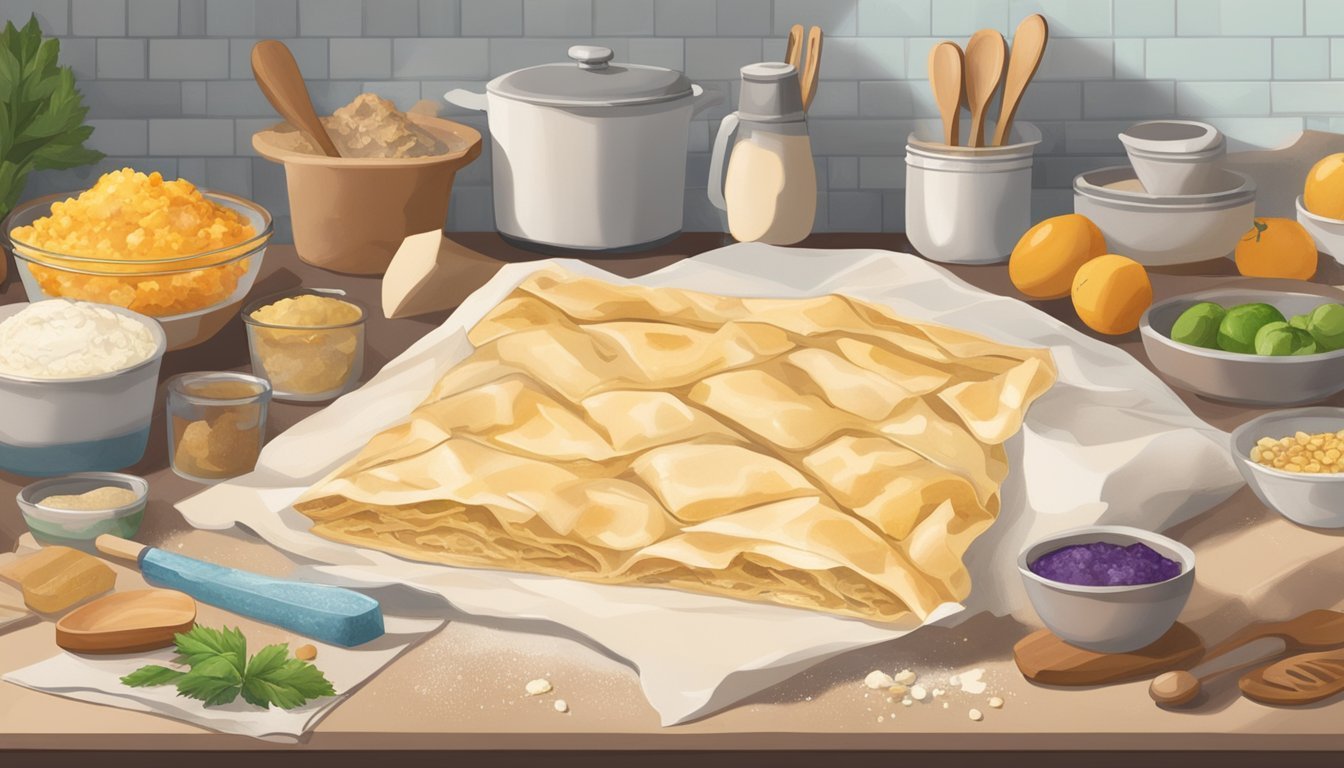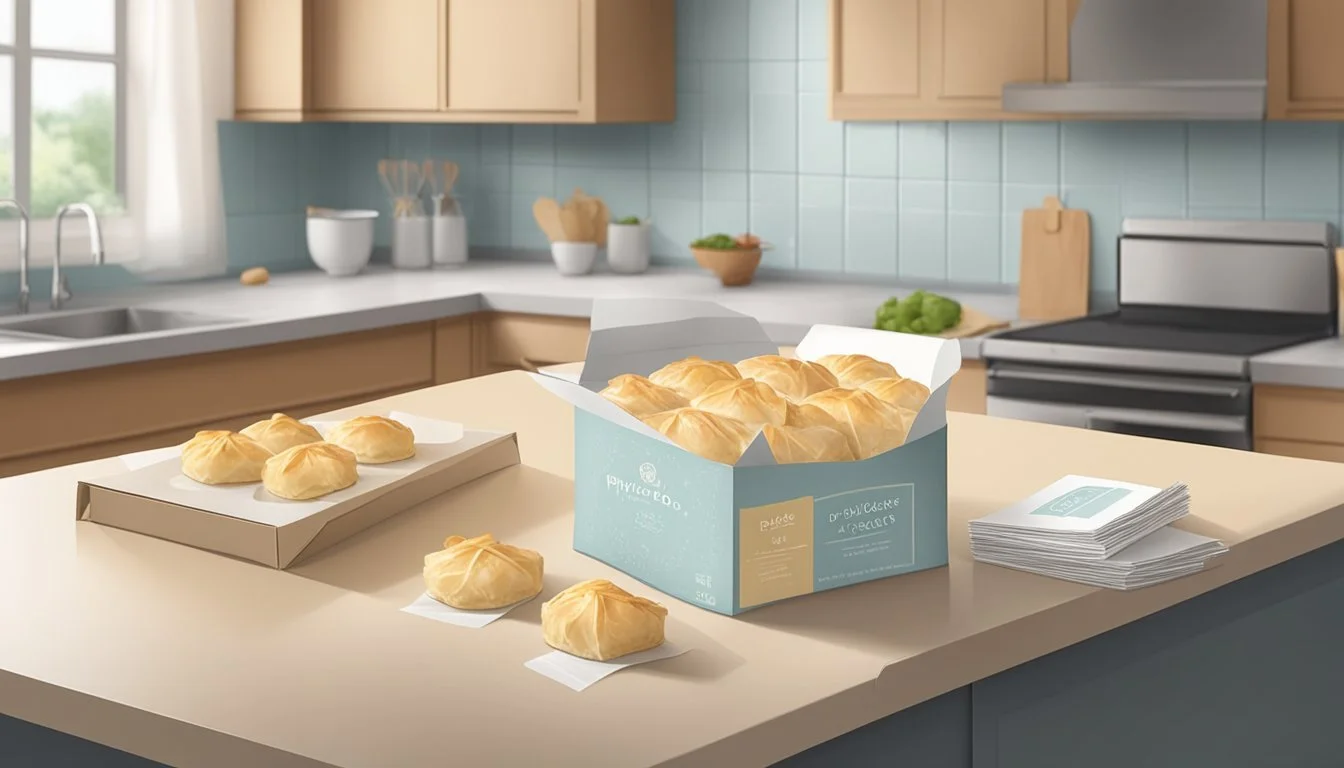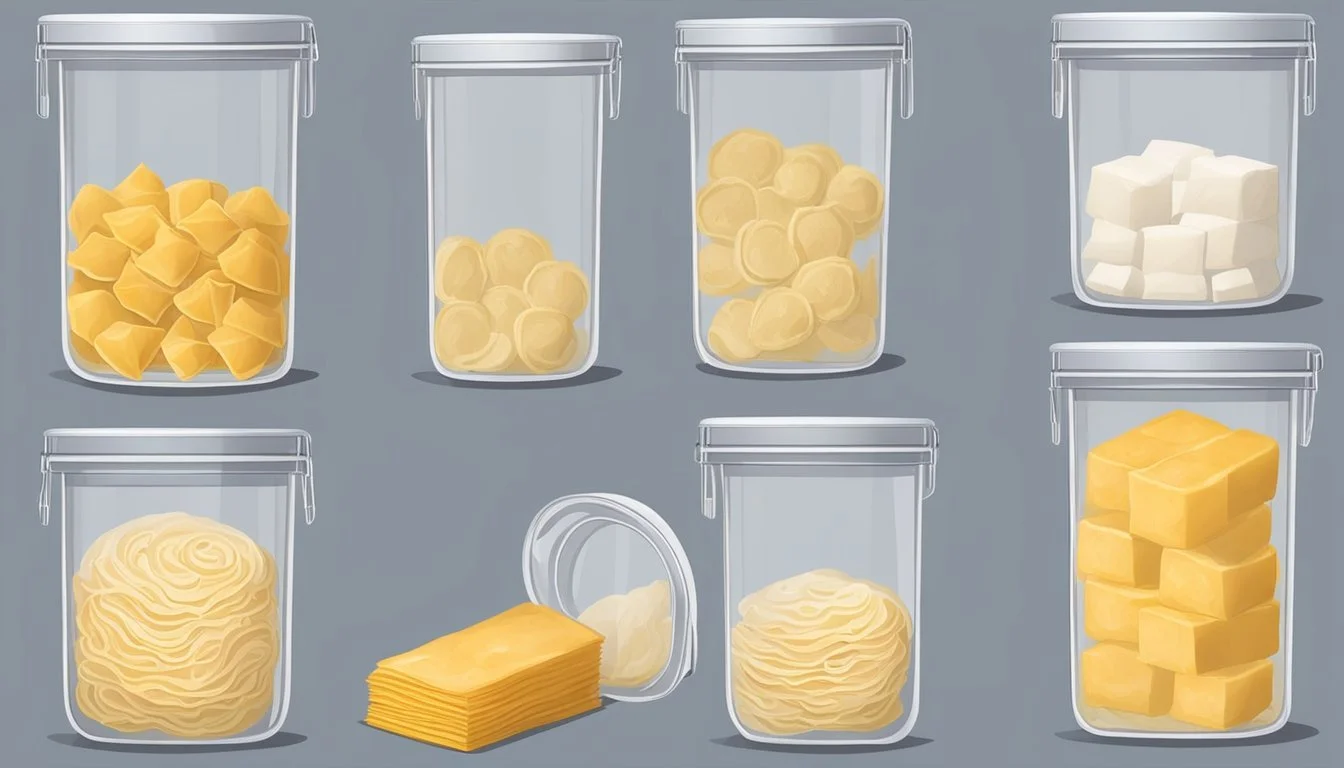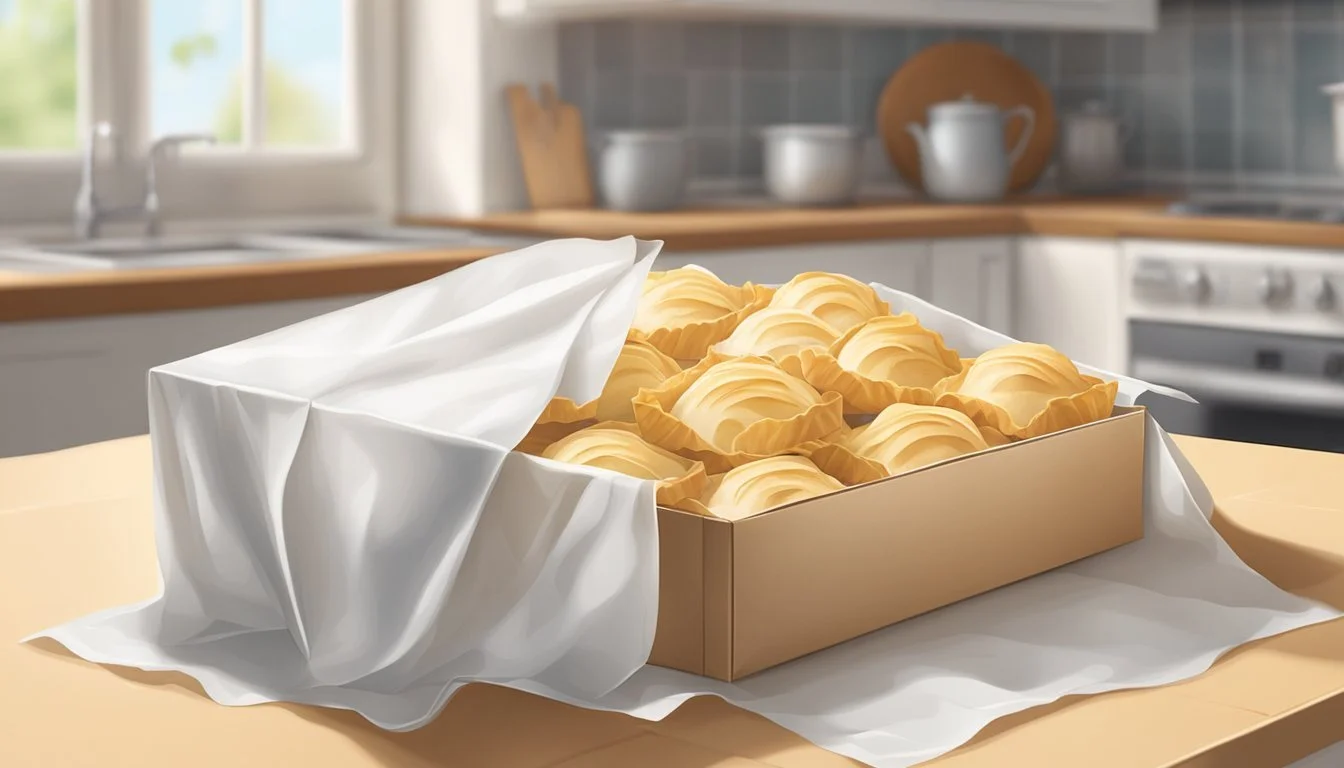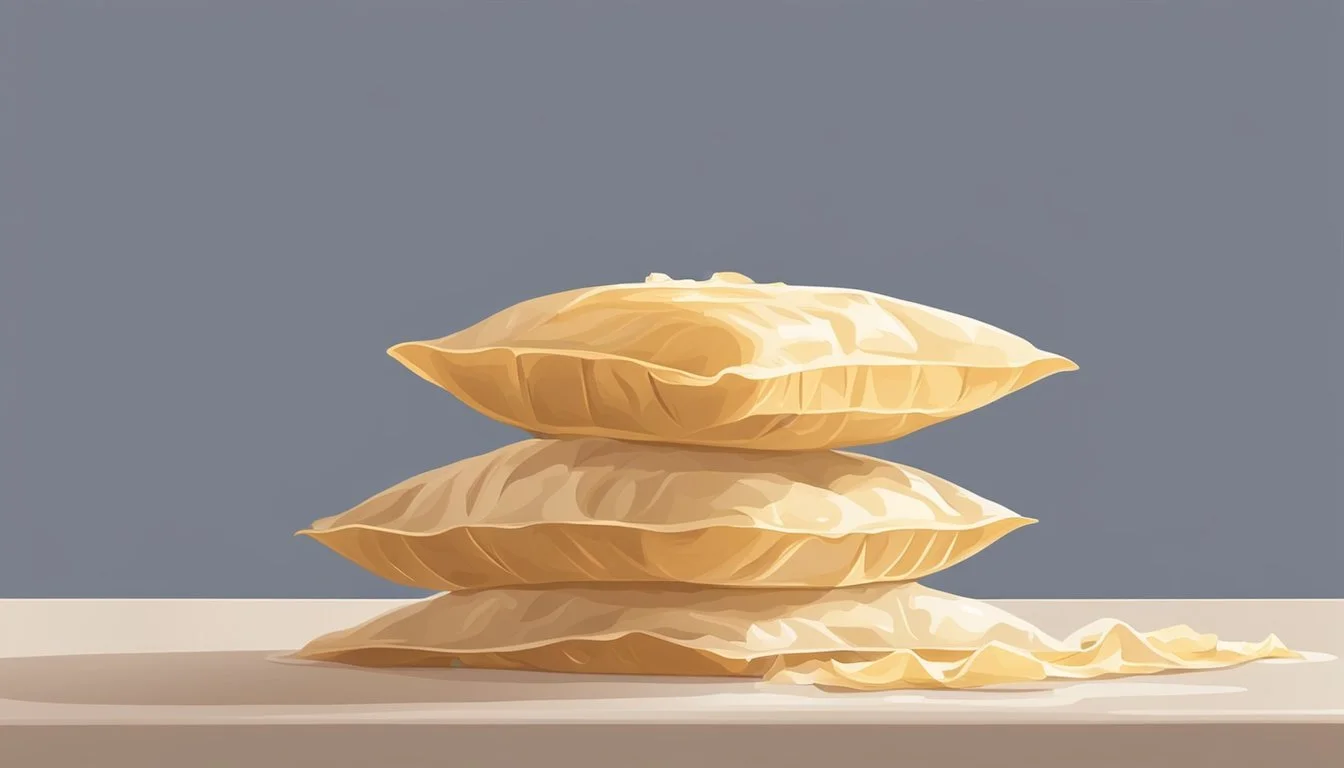Does Phyllo Dough Go Bad?
Storage Tips and Signs to Watch For
Phyllo dough, known for its delicate, thin layers, is a favorite in many kitchens for creating crisp and flaky pastries. Yes, phyllo dough can go bad, and its shelf life largely depends on how it's stored. Proper storage in the refrigerator or freezer can extend its usability considerably, but once it is thawed, it should be used within a few days to ensure quality.
When stored in the refrigerator, unopened phyllo dough can remain fresh for several weeks, while after opening, it must be used within a few days to prevent it from drying out or becoming too brittle. Freezing phyllo dough is an effective method to lengthen its shelf life, and it can last up to three months in the freezer without compromising its quality.
Handling phyllo dough with care is key to maintaining its best condition. Once thawed and unwrapped, keep the dough sheets covered with plastic wrap and a damp kitchen towel to prevent them from drying out. Proper handling and storage are essential to avoid spoilage and ensure that this versatile ingredient remains ready for creating delicious dishes.
Understanding Phyllo Dough
Phyllo dough, also known as filo or filo pastry, is a delicate, unleavened dough used for various culinary applications. It is composed of simple ingredients and is known for its versatility in both sweet and savory dishes.
Composition and Types
Phyllo dough consists primarily of flour, water, and a small amount of salt and oil. This combination creates a dough that can be rolled out extremely thin. The thinness of the dough is one of its defining characteristics, contributing to the flaky texture when baked.
Phyllo is available in various thicknesses, commonly labeled as #4, #7, or #10. These numbers indicate the fineness of the dough. #4 is very thin, suitable for delicate pastries, while #10 is thicker and preferred for sturdier dishes like baklava. Proper handling is crucial; phyllo should be thawed in the fridge if frozen and kept moist to prevent drying out.
Phyllo vs. Other Pastries
Unlike other pastries such as puff pastry or shortcrust, phyllo dough is unleavened. This means it does not rise or puff up, resulting in a crisp, layered texture when baked. Puff pastry, in contrast, incorporates butter within its layers and relies on the steam generated from the butter to create a rise.
Phyllo requires brushing each layer with oil or butter during preparation. This adds moisture and richness, helping create the characteristic flaky texture. The technique of layering and brushing is unique to phyllo and distinguishes it from other dough types which often involve folding or mixing in fats directly. This makes phyllo versatile for a variety of dishes, from savory spanakopita to sweet baklava.
Proper Storage Methods
Proper storage is essential to maintain the quality and safety of phyllo dough. Different methods apply depending on whether the dough is refrigerated, frozen, or dealing with leftovers.
Refrigerating Phyllo Dough
Refrigerated phyllo dough should be kept in its original packaging until ready for use. If the packaging is opened, cover the dough with plastic wrap to prevent it from drying out. For better protection, wrapping in aluminum foil is also recommended.
The fridge's environment can cause the dough to dry quickly. Therefore, make sure to use refrigerated phyllo dough within about two to three weeks to ensure optimal texture and usability. Always handle with care to avoid tearing the thin sheets.
Freezing Phyllo Dough
If you need long-term storage, freezing phyllo dough is ideal. Place unopened phyllo directly in the freezer where it can keep for up to three months. For opened packages, wrap the sheets in plastic wrap, then place them within a freezer-safe bag or an airtight container. This extra protection prevents moisture problems.
Defrost frozen phyllo dough gradually by placing it in the fridge overnight. Quick defrosting methods can lead to an uneven texture or soggy layers, which affect its performance in recipes.
Handling Leftover Phyllo Dough
When dealing with leftovers, proper handling is crucial to extend its life. Wrap leftover phyllo dough tightly in plastic wrap, followed by aluminum foil to seal out air. Store it in an airtight container for added protection.
Aim to use leftover dough within a few days if stored in the fridge. For longer storage, freezing works best. As with initially frozen dough, gradually defrost leftovers in the fridge to retain their quality. Ensure each sheet remains covered with plastic wrap and a damp towel during use to prevent drying out.
Shelf Life and Spoilage
Phyllo dough has a specific shelf life based on its storage conditions. It is important to recognize signs of spoilage to ensure safety and quality.
Identifying Spoiled Phyllo Dough
Spoiled phyllo dough often has visible signs such as mold growth or an off smell. Mold may appear as green or black spots. If the dough smells sour or fermented, it is no longer safe to use.
Texture changes also indicate spoilage. Fresh phyllo dough should be soft and flexible. If it feels excessively dry, brittle, or sticky, it may have gone bad. Discoloration, such as yellowing or blotchy spots, is another sign of deterioration.
Dough that has been improperly stored can spoil faster. Keeping an eye on these indicators helps prevent the use of compromised ingredients.
Factors Affecting Shelf Life
The shelf life of phyllo dough varies with storage methods. Refrigerated phyllo dough typically lasts up to 3 days if kept in a tightly sealed bag or wrapped in plastic to retain moisture.
Frozen phyllo dough can maintain its quality for about 3 months when stored in its original packaging or an airtight container. Proper defrosting is crucial. Thaw dough in the fridge overnight or at room temperature for a few hours. Avoid opening the package until ready to use to prevent moisture loss.
Storage conditions impact spoilage. Keep phyllo dough in a cool, dry place. Exposure to moisture during storage can lead to mold growth and spoilage. Proper packaging and careful handling help extend its usable life.
Thawing and Preparation
Proper thawing and preparation are essential for maintaining the delicate texture and usability of phyllo dough. These steps ensure that the dough does not become too sticky or break apart before use.
Thawing Frozen Phyllo Dough
Phyllo dough must be thawed slowly to preserve its consistency. Start by placing the frozen dough in its original packaging in the refrigerator. Allow it to thaw for 6-8 hours or overnight. This gradual defrosting prevents excessive condensation, which can make the dough gummy and difficult to work with.
Once thawed in the refrigerator, let the dough sit at room temperature for about 2 hours. This step ensures that the dough is pliable and easy to handle when you are ready to use it.
If time is limited, phyllo dough can be thawed in the microwave. Place the dough on a plate and set the microwave to the lowest power setting. Thaw in 30-second intervals, checking frequently to avoid cooking the dough. Continue this process until the dough is thawed.
Preparation Best Practices
Handle phyllo dough with care, as it is very delicate. Use a slightly damp cloth to cover the phyllo while working with it. This prevents the dough from drying out and tearing.
When ready to use, gently separate the sheets to avoid ripping. Phyllo dough tends to be fragile, so work on a clean, dry surface and use a soft brush to apply butter or oil between layers.
Prepare your filling beforehand to ensure a smooth assembly process. Working quickly can also help maintain the dough’s moisture, making it easier to handle.
Storing unused phyllo properly is vital. Keep the remaining sheets wrapped tightly and store them in the refrigerator for up to a few days or refreeze if needed.
Implementing these best practices guarantees that your phyllo-based dishes maintain their intended texture and crispness.
Working with Phyllo Dough
Working with phyllo dough involves careful thawing, handling, and proper techniques to ensure the delicate layers remain intact. Specific methods and tips help in preventing common issues like tearing or drying out of the dough.
Techniques for Success
When handling phyllo dough, thaw it overnight in the refrigerator while keeping the package closed. This prevents the outer layers from becoming gummy. Ensure your work surface is large enough and free of moisture. Work with one sheet at a time, keeping the others covered with plastic wrap and a damp kitchen towel to prevent them from drying out.
Use melted butter or olive oil between each layer for a golden finish. A pastry brush helps apply a thin, even coat. Stacking 5 or more sheets together is common in most recipes. Use parchment paper during rolling for easy handling and transferring of the dough. A rolling pin can be used for gentle flattening if necessary.
Common Mistakes to Avoid
Never thaw phyllo dough at room temperature as it can make the dough gummy or dry. Do not skip covering the unused sheets; exposure to air makes them brittle quickly. Avoid using too little butter or oil as it can result in a dry texture.
Using too much fat can cause the dough to become soggy. Ensure that the phyllo stays cold during preparation; if it warms up, it's more prone to tearing. Keep your work area organized and clean to manage the delicate sheets effectively.
Lastly, follow baking instructions carefully; improper temperatures can impact texture. Baked phyllo should be stored in an airtight container or frozen if not consumed immediately to maintain its crispiness.
Recipes and Applications
Phyllo dough is exceptionally versatile, allowing for a wide range of both savory and sweet recipes. Each preparation highlights the unique characteristics of phyllo, making it a go-to ingredient in various kitchens.
Savory Phyllo Delights
Spanakopita, a traditional Greek spinach pie, is a favorite savory application. Layers of phyllo dough encase a filling of spinach, feta cheese, and herbs, creating a crispy outer texture with a flavorful and moist center.
Phyllo dough is also perfect for making appetizers such as savory triangles, filled with combinations like cheese and herbs, ground meat, or vegetables. These triangles are baked to crisp perfection, making them ideal for finger foods at parties.
Another classic is savory pies and strudels. Phyllo dough can be wrapped around fillings such as cheese, potatoes, or mushrooms. These dishes often serve as main courses, bringing a rich taste that is delightful with a flaky texture.
Sweet Phyllo Treats
Baklava stands out as one of the most popular sweet uses of phyllo dough. This dessert layers phyllo with chopped nuts and honey, producing a sweet, sticky, and crunchy treat.
For lighter desserts, phyllo can be used to make fresh fruit tarts. These tarts typically involve a phyllo crust filled with custard and topped with seasonal fruits, blending creaminess and crunch.
Snack lovers will appreciate Nutella and banana pastries. These treats involve spreading Nutella and bananas between layers of phyllo, then baking them until golden brown.
Phyllo dough is also excellent for making strudels filled with apples or other fruits, bringing a mix of sweetness and acidity wrapped in a crispy layer.
Phyllo Dough Tips and Tricks
To achieve the best results with phyllo dough, attention to technique and creativity in usage can make a significant difference. Below are some tips and ideas to help you work with phyllo dough effectively.
Achieving Perfect Texture
Keep Phyllo Dough Covered: Phyllo dough dries out quickly when exposed to air. Always cover it with a slightly damp towel or plastic wrap to maintain its moisture and prevent it from becoming brittle.
Thaw Properly: If using frozen phyllo, thaw it overnight in the refrigerator. Let it sit at room temperature for an hour before use. Avoid defrosting it at room temperature to prevent the outer layers from becoming gummy.
Use All-Purpose Flour: Lightly dusting your work surface with all-purpose flour can help prevent sticking, making it easier to handle the delicate sheets.
Apply Butter or Oil: Brushing each layer with melted butter or oil not only helps achieve a flaky, golden brown finish but also keeps the layers separated.
Creative Uses and Ideas
Use Breadcrumbs for Added Texture: Sprinkling fine breadcrumbs between layers can add texture and absorb any excess moisture from the filling.
Experiment with Fillings: Phyllo dough is versatile and can be filled with various ingredients, from traditional nuts and honey for baklava to savory options like spinach and feta.
Incorporate Vinegar into Homemade Phyllo: Adding a small amount of vinegar to the dough can make it more pliable and easier to roll out thinly without tearing.
Try Wet Fillings with Care: If using a wet filling, make sure it is well-drained to avoid soggy layers. Pre-cooking the filling or adding breadcrumbs can help manage moisture levels.
Creative Shapes and Sizes: Phyllo can be shaped into cups, rolls, or layers, allowing for diverse presentations from appetizers to desserts.
Utilizing these tips ensures phyllo dough retains its crispy, flaky charm in any dish, making both traditional and innovative recipes a success.
Cultural Significance of Phyllo
Phyllo dough holds a special place in various world cuisines, renowned for its delicate, flaky texture. It plays a pivotal role in numerous iconic dishes, the importance of which extends beyond mere taste to cultural heritage and tradition.
Phyllo in World Cuisine
Phyllo dough is a staple in Greek and Middle Eastern cuisines. In Greece, it is often found in both savory and sweet dishes. A traditional Greek item is tiropita, a delicious cheese pie made with layers of phyllo and feta cheese. Phyllo's versatility is demonstrated in its use in baklava, a rich dessert enjoyed across the Middle East, where layers of phyllo, nuts, and honey create a symphony of flavors.
In Austria, phyllo is integral to apple strudel, a rolled pastry filled with spiced apples. This dessert highlights how phyllo can be both robust and delicate, holding the filling while providing a crisp texture. Phyllo's ability to encapsulate a wide variety of fillings shows its global culinary importance.
Iconic Phyllo Dishes
Tiropita is more than just a cheese pie; it is a symbol of Greek hospitality and comfort food. Made with phyllo, it combines creamy feta cheese with the salty, crunchy layers of the dough, offering a satisfying texture and flavor experience. It is commonly served as a snack or appetizer.
Baklava is perhaps the most famous of phyllo dishes, beloved in Middle Eastern cultures. It consists of numerous layers of phyllo filled with pistachios or walnuts, sweetened with honey or syrup. Its preparation and consumption are often tied to festive occasions and celebrations.
Apple strudel, originating from Austria, utilizes phyllo to create a delicate, crispy shell that houses the sweet and spicy apple filling. The careful rolling of phyllo sheets encapsulates the essence of traditional Viennese baking and showcases how a simple dough can be transformed into a culinary masterpiece.
Health and Nutrition
Phyllo dough has a unique nutrient profile and several dietary considerations to keep in mind. It is low in fat but contains gluten, making it unsuitable for those with celiac disease.
Caloric and Nutrient Information
Phyllo dough is relatively low in calories. A single sheet weighing about 19 grams contains approximately 56.8 calories. It also has minimal fat content, with less than 0.5 grams of saturated fat per serving. This makes phyllo a healthier option compared to traditional pie crusts or pastry dough.
Nutrient-wise, phyllo dough consists mainly of carbohydrates. It contains small amounts of protein and almost no fiber. Notably, the dough has trace amounts of vitamins and minerals but is not a significant source of any particular nutrient.
Dietary Considerations
Phyllo dough is made from flour, water, and a small amount of oil or butter. This composition means that it contains gluten, which is unsuitable for individuals with gluten-related disorders.
For those focused on dietary fats, phyllo dough is lower in fat compared to many other doughs. However, if butter or oil is used during preparation, the fat and calorie content will increase. Also, while commercial phyllo is typically made from refined flour, some versions use whole grain flour, providing additional dietary fiber and nutrients.

